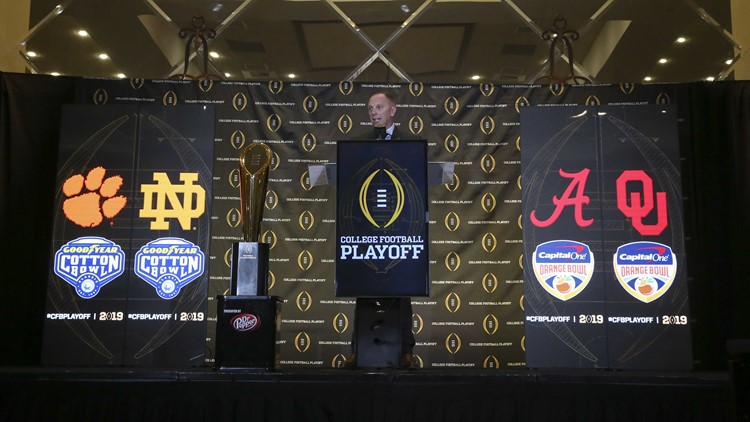WASHINGTON, D.C. — The fifth College Football Playoff bracket was revealed Sunday with little suspense, practically no controversy and few legitimate complaints from Georgia and Ohio State, who were snubbed for the fourth spot in favor of Oklahoma.
Though some of the sport’s tastemakers were swayed by Georgia’s strong performance in a losing effort to Alabama on Saturday, the CFP’s selection committee went by the book in rewarding a conference champion, played it safe in taking a one-loss team over a two-loss team and made the decision to reward the team that had the better season. In other words, the committee did exactly what it was designed to do.
But lost in the arguments over the last week about whether the playoff should be four or eight and the hair-splitting bout whether four best teams actually means four most deserving is a structural problem with the sport that the Playoff was designed to solve but actually has made worse.
Since the inception of the four-team format, there have now been 20 playoff spots awarded. With Notre Dame making it for the first time this year, they have now gone to a grand total of 10 different schools.
Even in a sport that has been defined by dynasties and epochs of greatness, at what point does the reliability of college football’s top programs being in the Playoff start to become a little bit stale?
For the third time in the last four years, Alabama, Oklahoma and Clemson made the Playoff in the same year. While this year’s matchups look good on paper, Las Vegas oddsmakers have installed both Clemson and Alabama as double-digit favorites, which means they will be heavily favored to meet for the fourth straight year in the Playoff on Jan. 7 in Santa Clara, Calif.
Hey, doesn’t someone else want to be part of this thing?
Look, it’s nobody’s fault. The Playoff is supposed to about excellence, not participation trophies, and you can’t argue against Alabama, Clemson and Oklahoma, which are a combined 153-14 over the last four seasons. Credit to them for being so far ahead of their competition that they are usually able to make it through their conference seasons with zero or one losses.
But if the primary argument against the old BCS was that it didn’t give enough teams a fair shot to compete for a national championship, the Playoff has actually seemed to narrow the field rather than expand it.
In the final seven years of the BCS, for instance, five different schools won national championships and 10 played for it. Between 2007 and 2010, you didn’t have a single program get to the title game more than once.
That’s not an argument for the old system, by the way. It stunk. Over the history of the BCS, some deserving teams were excluded and some teams that sailed into a title shot by riding an undefeated record up the polls without enough schedule substance behind it.
But if nothing else, some of those BCS matchups felt exciting because we weren’t seeing the same teams year after year after year. (The closest the BCS came to feeling repetitive was when Ohio State got blown out by SEC teams in 2006 and 2007).
Some of the blame may here may rest on the shoulders of conference realignment, which really started to hit just as the BCS was winding down.
The addition of teams to the SEC and ACC may have expanded its television footprint, but it watered down the schedules to the point where good teams were playing each other less often, making the path somewhat easier year in and year out. If the SEC’s schedule rotation, for instance, had landed on Georgia and Alabama playing each other the last two years it would have had a profound effect on the Playoff picture. Instead, they won’t play again in the regular season until 2021.
For the Big 12, on the other hand, losing Texas A&M, Missouri, Colorado and Nebraska and replacing them with TCU and West Virginia made the conference significantly weaker, with fewer programs in the league that were equipped to recruit at Oklahoma’s level. Texas is just now getting back on its feet under Tom Herman and could become a legitimate obstacle in the future, but for the last few years, Oklahoma’s path has been pretty clear.
Check out the top 10 teams in the country according to the Amway Coaches Poll following Week 14 of the college football season. USA TODAY Sports
And given the way all those schools are operating relative to their peers, there’s little reason to think the makeup of the Playoff will look significantly different over the next five years. You’re going to see plenty of Alabama, Clemson, Oklahoma, Georgia and Ohio State in the mix for those coveted spots going forward.
The question, since we’re not going backward to the BCS system or smaller conference, is what can be changed to spice things up?
One radical idea would be to overhaul scheduling models and come up with an NFL-like formula that would add tougher opponents both in and outside the conference based on what teams did the previous year. Essentially, it would work like a golf handicap — the better you are, the tougher schedule you have to face.
But given how unlikely that is to happen — What would Alabama do without its November date with the Citadel? — the next-best idea is playoff expansion that starts the week after the regular season with higher seeds playing at home venues and without a month off to heal the bumps and bruises.
Based upon the committee’s rankings this year, the quarterfinal matchups would have looked like this: UCF at Alabama, Michigan at Clemson, Ohio State at Notre Dame, Georgia at Oklahoma.
Only someone who hates fun would take the current slate of semifinals over the variety and spice of those matchups and storylines.
Make no mistake, the current Playoff has been an improvement for college football. But after seeing the same teams pop up year after year in the four-team format, it soon will need to offer something new.



